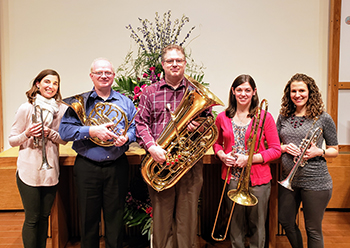by Nicholas Stevens

Fortunately, the Northeast Ohio-based Diamond Brass pursue the new while respecting the classics. In their April 8 concert hosted by Rocky River Chamber Music Society as part of its 60th season, commissioned and otherwise fresh music dominated an evening that also included staples of quintet literature. Diamond Brass brought sounds both incisive and mellow to West Shore Unitarian Universalist Church. While the hard-walled hall is on the small side for this type of ensemble, it nonetheless blended the quintet’s sound well. Only a moment or two was at the verge of overwhelming force.
Composer Andrew Rindfleisch was in attendance for Diamond Brass’s performance of his In the Zone, a sweet-and-sour tribute to the sacred repertoire that serves as the bread and butter of the brass ensemble world. Straightforward, triumphant tunes unfold, only to turn dissonant later on, making this a bold choice of opener. The group, especially first trumpet Nina Bell, played with crisp articulation. Bell and hornist Greg Hillis sounded fantastic in octaves during John Cheetham’s Scherzo, the lively romp that followed.
Next came Ballyhoos and Hullabaloos, a new suite by Rindfleisch commissioned by the Chamber Music Society in celebration of the anniversary season. Demanding enough that an intermission divided its world premiere into two halves, the piece features each instrument in turn. Trombonist Whitney Clair displayed equal measures of gusto and mastery in the first movement, scooping and diving through the middle and high registers with gorgeous vibrato and tasteful exuberance. Tubist J.c. Sherman gave plush tone and appealing shape to the dreamy melody of the second movement, placing a humorously out-of-sync final note with perfect comic timing.
Returning from the interval, the quintet sounded refreshed for the third movement. Bell and second trumpet Amanda Bekeny blended wonderfully in a duet of hesitant fragments, played first with practice mutes and then, luxuriantly, without. Clair and Sherman’s eventual entrance under the duet partners yielded a chill-inducing harmony. A dissonant opening paved the way for Hillis’s moment to shine. Short both in duration and on opportunities for its featured player to enjoy the limelight uninterrupted, this finale poses daunting challenges. Hillis nonetheless played with technical polish and fierce energy, whooping and soaring all the while.
Substituting a quintet classic, Wilke Renwick’s Dance in place of a planned Bach selection, the ensemble nailed a series of tricky shifts in pulse while bubbling along at a brisk tempo. Surging trumpet scales from Bell and Bekeny gave life to the first movement of Malcolm Arnold’s Quintet for Brass, and Clair excelled in a solo in the slower second movement. After the strange swirling of cup-muted trumpets over Sherman’s lush bass tones, a pristine final chord brought closure to this cornerstone of the ensemble literature.
Published on ClevelandClassical.com April 26, 2019.
Click here for a printable copy of this article



